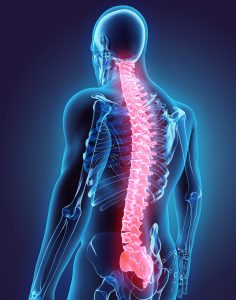How Can Spinal Cord Stimulators Help Accident Victims?
 Spinal cord injuries (SCIs) can cause unbearable chronic pain. In severe cases, spinal cord injuries can cause partial or full paralysis. These injuries can result from many different types of accidents, such as car crashes, slips and falls, construction accidents, and product defects. Many victims never fully recover from spinal cord injuries and experience unbearable pain and suffering.
Spinal cord injuries (SCIs) can cause unbearable chronic pain. In severe cases, spinal cord injuries can cause partial or full paralysis. These injuries can result from many different types of accidents, such as car crashes, slips and falls, construction accidents, and product defects. Many victims never fully recover from spinal cord injuries and experience unbearable pain and suffering.
In addition, medical treatments are expensive. At Harris Lowry Manton LLP, our experienced Atlanta and Savannah trial lawyers have obtained numerous high-figure verdicts and settlements for spinal cord injury victims, including:
- $18,000,000 for failure to diagnose a spinal epidural abscess
- $10,000,000 for an automobile defect resulting in spinal cord injury
- $9,800,000 for a spinal cord injury from defective construction
According to the Mayo Clinic, treatments for spinal cord injuries include medication, immobilization, and surgery. Epidural injections are also a fairly common treatment. One treatment that pain doctors, neurologists, and neurosurgeons may consider is the use of a spinal cord stimulator, which is typically is used along with other pain management treatments. A spinal cord stimulator is implanted into your body and allows the user to control the transmission of low electricity levels directly into the spinal cord to help relieve pain.
According to Johns Hopkins Medicine, a spinal cord stimulator is a last resort – used after other nonsurgical pain options have been explored and failed. There is a two-step process involved:
- The first step is a trial run to determine if the stimulator works
- The second step is to implant the device permanently
Neurosurgeons or physicians who are highly trained in interventional pain use a fluoroscopy (a type of X-ray) to insert the electrodes and determine, with your feedback, where your pain is. The trial only requires one incision. The battery is outside your body. If successful (your pain is reduced by 50% or more), doctors will consider an implant. If the trial is not successful, the wires are removed.
The procedure takes about one to two hours and is usually performed in an outpatient facility. There are normally two incisions – one for the generator and one for the permanent electrodes. The incisions may be painful for a few days and usually heal within a few weeks, when you may start light activities. Normally, after consultation with your doctor, you may begin driving again (the stimulator is turned off while you drive) and return to work.
Complications may include infections, bleeding, device migration, and other disorders. One note – the stimulators will set off airport security. Your doctor should give you an ID card to allow you to bypass the security machines. You may need to turn your device off before passing through security.
How do spinal cord stimulators work?
Spinal cord stimulators are composed of electrodes made up of thin wires and a generator resembling a small battery pack or pacemaker.
The electrodes are spaced between the patient’s vertebrae (in the epidural space) and the spinal cord. The generator is positioned under the patient’s skin – normally, near the abdomen or buttocks. The patient uses a remote control and antenna (which are positioned outside the body) whenever they feel pain, sending electrical impulses from the generator through the electrodes.
Standard spinal cord stimulators replace the pain feeling with a light tingling sensation called paresthesia. If a patient does not feel that the paresthesia sensation is helping, newer stimulators use a “sub-perception stimulation that cannot be felt.”
When is spinal cord stimulation used?
A spinal cord stimulator is usually considered when nonsurgical pain treatments have failed to provide the necessary pain relief. Spinal cord stimulators are used for the following injuries:
- Back pain, typically when back surgery does not help
- Pain after surgery
- Spinal cord injuries
- Pain after an amputation
- Nerve-related pain (such as pain from chemotherapy, cancer-related neuropathy, and diabetic neuropathy)
- Peripheral vascular disease
- Other medical disorders
When successful, spinal cord stimulators help patients sleep, reduce the desire for pain medications, and improve a patient’s overall quality of life. Other complementary treatments include physical therapy, relaxation methods, and exercises.
When should you consider a spinal cord stimulator?
Your pain management doctor or other treating physician will normally conduct various imaging tests and conduct a psychological screening to help you decide if a spinal cord stimulator trial is a good idea for your chronic pain.
According to the Mayo Clinic, imaging tests include:
- X-rays. This diagnostic can test show if there is damage to the spine, including degenerative changes, tumors, and fractures.
- Computerized tomography (CT) scan. This test is better at finding abnormalities than X-rays. A variety of cross-sectional images is created to see if you have disk, bone, or other disorders.
- Magnetic resonance imaging (MRI). This test produces computer-generated images that help doctors determine if there is compression of the spinal cord from clots, masses, or herniated disks.
Your insurance company may require a psychological assessment to determine if any emotional problems such as anxiety or depression are worsening your pain. Our experienced spinal cord injury lawyers understand the need for these tests when we are fighting to have the insurance companies for the liable parties pay for your spinal cord stimulator review and implant.
What are the types of spinal cord stimulators?
John Hopkins Medicine states that the three main types of spinal cord stimulators are:
- Conventional implantable pulse generator (IPG). This stimulator is battery-operated. The battery is placed in your spine. Additional surgeries are needed when the batteries run out. This implant method is considered if an accident victim has localized pain that requires less electrical output.
- Rechargeable IPG. This implant device is similar to the conventional device except that the battery can be recharged – so you do not need additional surgeries. These devices can emit more electricity. They are considered for accident victims who have pain in the legs or lower back.
- Radiofrequency stimulator. This implant device uses a battery located outside your body. The batteries are rechargeable. These are not commonly used because of improved technology in the other devices.
Your doctor can explain how to operate whichever spinal cord stimulator is implanted and how to adjust the electric signal’s intensity. The settings may differ depending on whether you are walking or sitting. Normally, your surgeon presets a few programs.
At Harris Lowry Manton LLP, our spinal cord injury lawyers understand just how unbearable spinal cord pain can be. We demand compensation for all your physical pain, emotional suffering, and lost income. We also demand payment for all your medical expenses, including the cost of any reasonably necessary trial and permanent spinal cord stimulator implants.
When you are harmed by another’s negligence, you have the right to take action to restore your health. To discuss your personal injury rights with experienced and respected litigation lawyers, call our Atlanta office at 404-998-8847, our Savannah office at 912-417-3774, or complete our contact page.
Related Articles
- How Car and Truck Accidents Can Lead to Spinal Cord Injuries in Georgia
- The Lifetime Costs of a Spinal Cord Injury
- What Are the Levels of Spinal Cord Injury?
- What You Should Know about Spinal Cord Injuries

One of the nation’s top trial attorneys, Jeff Harris is an award-winning litigator who handles high-profile, complex cases across a wide variety of practice areas. He excels at securing justice for clients who have been seriously injured or killed, holding responsible parties accountable for their actions as well as their negligence.
Read more about Jeffrey R. Harris here.
